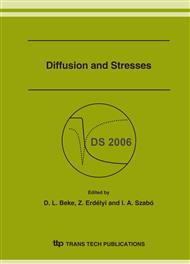p.91
p.99
p.109
p.117
p.123
p.133
p.141
p.151
p.155
Stress Relaxation Mechanisms during Cd21Ni5 Intermetallic Growth under High Hydrostatic Pressure
Abstract:
Stress relaxation processes accompanying intermetallic growth during reactive diffusion between Cd and Ni have been studied by the methods of optical and scanning electron microscopy, provided with X-ray microanalysis. The experiments were carried out with the two-layer Cd-Ni samples at 250 and 280oC under hydrostatic pressures 350-900 MPa. The observed processes have been compared with those occurred at low pressures to demonstrate that the mechanisms of stress relaxation and thus the kinetics of intermetallic growth essentially depend on applied hydrostatic pressure. New mechanisms of stress relaxation were found, such as Cd extrusion and Cd whisker growth, which accompanied formation of Cd21Ni5 compound. It is shown, that the whisker growth is more probable at lower temperatures when the grain size is smaller, and the stress gradient, which support a driving force for whisker formation, is higher. An atomic mechanism for whisker growth, based on diffusion climbing of dislocation loops produced by Bardeen-Herring source for building new atomic layers, has been discussed.
Info:
Periodical:
Pages:
123-132
Citation:
Online since:
April 2007
Price:
Сopyright:
© 2007 Trans Tech Publications Ltd. All Rights Reserved
Share:
Citation:


